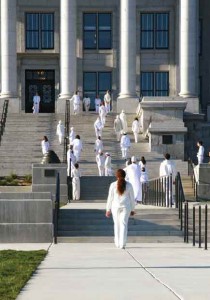« Reviews
Ernesto Pujol: Awaiting
Performance at Utah State Capitol Building - Salt Lake City
By Cara Despain
In Spring 2010, conceptual and performance artist Ernesto Pujol became the first-ever recipient of a visiting artist residency at the University of Utah. Pujol first became recognized in the art world for his elaborate narrative installations in the 1990s. His more recent performance-based work can be distinguished by its emphasis on sociality and community, alongside a concern with global religious cultures and visual sensibilities. For his project in Salt Lake City, he created Awaiting-a 12-hour durational performance that took place on the steps of the Utah State Capitol building. Awaiting aimed to return the participants and viewers to a more natural sense of time, and to a space of personal and silent reflection. It also aimed to use the site of the Capitol building-a classically austere, white structure atop a hill above the city-as a Jacob’s Ladder. It was his largest performance piece to date, and involved forty students/volunteers in total, dressed in all white, silently walking from remote locations throughout the city to gather at the Capitol. Collecting themselves in a vaguely confrontational formation, all the participants silently engaged with the institutional bronze words “State of Utah” at the foot of lawn. They then adjourned to the expansive steps of the Capitol, where they very slowly and quietly completed night-long, counterclockwise foot patterns before uneventfully dispersing again at dawn.
In this particular region of the country, the collision of white garb-Pujol’s signature color employed consistently in his group performances-and official state architecture unavoidably created an association with holy clothing within the Mormon religion. In some ways, the goals of Awaiting were obscured by the local history and its predominant Mormon faith. It seemed to simultaneously engage and negate, utilize and oppose, the obvious local associations. In his extensive research for this project he was stuck by what he found to be a fascinating “culture of waiting.” His interest in globalism, which entails extrapolating commonalities between communities while remaining regionally relevant, is something on which his site-specific works hinge. As he describes his process: “It’s taking the wealth of a place and harvesting it.” In Utah, he feels, there is a also a history of waiting-on the part of the Mormon pioneers, today’s military families, and people in the Mormon faith who continue to wait for divine second coming. In contending with history and heritage, there are certain considerations that an “outsider” (as Pujol refers to himself) must make. The color white imposed on the figure-which Pujol states he uses for its association with secularism, neutrality and enlightenment-has an inescapable and significant association with the Mormon faith (it is the color of their most sacred garments worn during and after temple visitation) that was not directly acknowledged in the project’s aim. It was difficult to divorce this association, particularly with the temple visible from the performance site. While this impression was lessened by nightfall, during the day it seemed to also communicate a stray-from-the-aim political statement of people of faith swarming the State Capitol-which carries a fairly heavy implication for those familiar with the state’s politics. When coupled with the Jacob’s Ladder concept, things got a little fuzzy. Using the concept of religion as a general starting point opens up his projects to a certain level of spiritual interpretation-and the imposition of his own spiritual curiosities (Zen and meditative practices being the most pervasive), which come with their own dogma, can complicate matters.
The meditation-based idea of Awaiting sort of raises the question: can the public experience the piece effectively in the same way as the performers? The individual was to be de-emphasized, functioning as part of a collective, and the audience was to complete the experience. Being on the outside of the group of white-clad performers, the audience experienced the piece more as spectators-akin to watching someone meditate, versus actually performing meditation. While they are both relevant experiences inverse of each other, they are intrinsically divided. Observing the strange silence, and the resulting subtle sounds and movements that Awaiting made you aware of-especially in the brisk post-midnight hours-were the elements that succeeded most in their aim of returning all involved to stillness and reflection, and were the most interesting to witness.
(April 8, 2010)
Cara Despain is an artist, critic, art writer and curator. She is currently co-curator of GARFO Art Center and faculty at the Visual Art Institute (Salt Lake City, UT).
Filed Under: Reviews



































